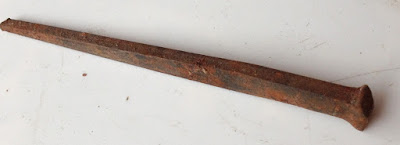A hand-forged nail, possibly made in Preston smithy.
A nail
was the first job of the apprentice blacksmith. A rod of iron was heated,
forged into a point then hammered flat at the top to form the head. This was a
deceptively difficult task. When the young smith had mastered this, he was
allowed to attempt more complex work.
Forging
iron tyres for cart and wagon wheels was another important task. A strip of
iron was heated, curved, and welded into a hoop. The implement on the smithy
wall, shown above, was used to shape the tyre. The holes on the bracket had
pegs through them which, when the iron was fed through, would force a curve
into the metal when pressure was applied. When a complete hoop was formed, the
pegs were removed and the tyre lifted off.
Fitting
the tyre to the wheel was usually the wheelwright's job. The tyre was heated in
a fire until red-hot, then fitted over the wheel which was set on a stone
plate. Water was poured over it and the metal was hammered as it cooled to keep
it to the correct shape. As the metal shrunk, it compressed all parts of the
wheel immovably tight.
In later
years, when the forge had little work other than farriery, (see Day 86) the
bracket was simply used to hang up the horses' harness while they were shod.


No comments:
Post a Comment